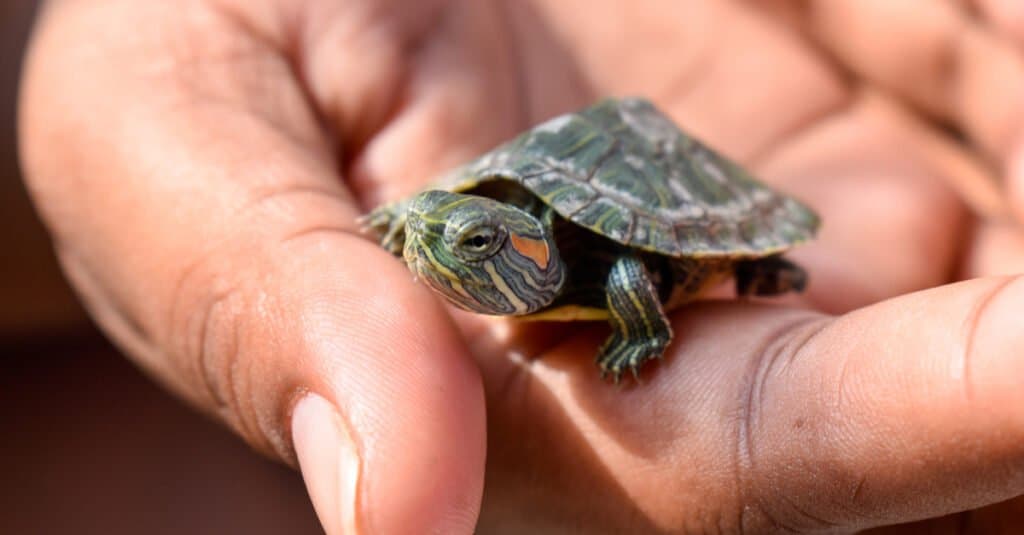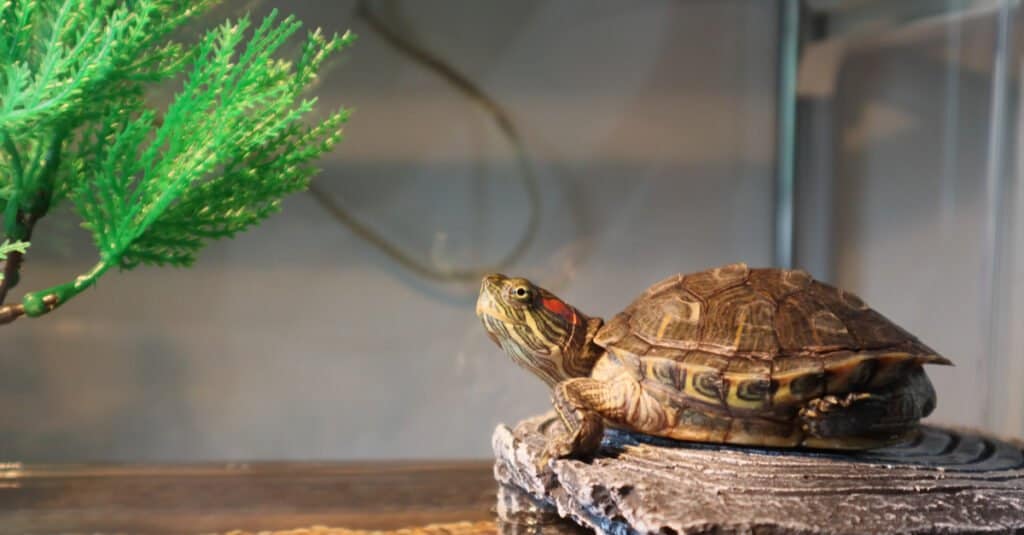Red-eared sliders make excellent pets for both beginner and expert reptile enthusiasts alike, but they need quite large enclosures to thrive in captivity. There are a few different options to choose from when it comes to housing one of these unique turtles, from standard glass tank aquariums to elaborate custom-built tubs and even outdoor ponds.
Read on to learn more about these enclosure styles below. I’ll go over each one in-depth as well as the supplies you’ll need for each to make your slider’s habitat a perfect home.
What Size Tank Does a Red-Eared Slider Need?

Despite their small size, red-eared sliders need large enclosures to swim in.
©Akash Naik/Shutterstock.com
Although they start out very small as babies at only a few inches long, red-eared sliders grow very quickly. However, you do have the option of starting your turtle out in a smaller enclosure as a baby until they reach their full size within a year or two. Alternatively, you could also place a baby red-eared slider in a full-sized tank with no issues. In fact, they’ll actually love having the extra space to explore!
As a general rule of thumb, red-eared sliders require at least 10 gallons of enclosure space for every inch of their shell length. For a baby turtle, an enclosure size of about 30 to 50 gallons is recommended. This size is only adequate until the turtle reaches around 1 to 2 years old, though! Once they reach adulthood, they’ll need at least 75 to 100 gallons to feel comfortable in captivity.
Additionally, as red-eared sliders are semi-aquatic, they need lots of open water to swim in at their leisure. The depth of the water at its deepest point should be at least twice the length of the turtle’s body. The total tank length should also be at least 5 to 6 times the length of the turtle’s body. Remember, your slider could live for 30 years or more, so the cost of a suitable, comfortable enclosure is a worthy investment.
What Type of Tank is Best For a Red-Eared Slider?

Regardless of the enclosure style you choose, there should ideally be at least 10 gallons of space for every inch of your slider’s shell.
©iStock.com/:Marina Vedernikova
There are a few different styles of tanks you can choose from for a red-eared slider depending on your preferences (and, if you want to keep them outdoors, where you live also matters). Standard rectangular glass aquariums, custom-built enclosures, and indoor/outdoor ponds are all great options for housing, though their price points vary significantly.
As I touched on earlier, size is the most important thing when it comes to creating an ideal habitat for your red-eared slider. As long as the enclosure is large enough, wet enough, and warm enough, you can get creative with its layout and design. We’ll cover the first two options in this section, then we’ll go over indoor/outdoor ponds below.
Standard glass aquariums are usually one shape: long and rectangular. This is typically the least expensive enclosure style, but it also provides the least amount of customization options since its shape can’t really be modified. Still, standard aquariums are durable and look great as a centerpiece in most homes for those wanting to show off their sliders.
Next, we have custom-built enclosures, which really run the gamut when it comes to shapes and layouts. These tend to be more expensive than pre-made glass aquariums. However, they can be heavily customized to suit your preferences. Buy locally if possible, as the cost of shipping these custom builds can be pricey. You won’t be able to find these enclosures in pet shops like you would a typical glass aquarium.
Both of these enclosure styles are excellent for red-eared sliders. They are durable enough to last for years, if not decades, if cleaned regularly and handled with care. However, many reptile hobbyists prefer building an elaborate pond to place their turtles in, which is even better if you can afford the costs of setting one up.
Can Red-Eared Sliders Be Kept in Ponds?

Red-eared sliders can thrive in various enclosure styles, though they most enjoy living in ponds.
©iStock.com/slowmotiongli
Finally, we come to indoor/outdoor ponds, which are typically the most expensive (but also the most customizable) out of the three options I’ve presented here. Outdoor ponds are only viable if you live in an area that’s warm year-round, as temperature fluctuations and predators can be very stressful and even harmful to sliders. Even if you do opt for an outdoor setup, it’s a good idea to have a backup tank indoors available in case you need to bring your turtle inside on an unseasonably cold day.
Indoor ponds can be tricky and costly to set up, but they make stunning displays with plenty of upkeep. These types of enclosures also come in more varied shapes and styles than standard glass aquariums. Indoor ponds can be made of various kinds of materials, but thick plastic tends to be the most common. You can raise the tub on platforms, surround it with decor, and essentially set it up wherever and however you’d like, which gives you a lot of room for customization.
Another issue with both indoor and outdoor ponds is they can’t be moved very easily, if at all. Keep this in mind when choosing a (likely permanent) location for your turtle’s habitat. Moving a red-eared slider’s enclosure often can cause them a lot of unnecessary stress anyway, so it’s best to keep it in one place they can get familiar and comfortable with.
What Supplies Do Red-Eared Slider Tanks Need?

Red-eared sliders thrive in warm temperatures, which you’ll need to provide with basking lights.
©Mark Leung/Shutterstock.com
Regardless of the enclosure style you choose, you’ll need to set it up with a few supplies to make your red-eared slider feel truly at home. These include the following:
- Basking/heat lighting
- UVB lighting
- A high-quality water filter
- Substrate for the bottom of the tank
- A few easily-accessible platforms for basking
- Humidity and temperature gauges to monitor air and water temperature
- Decorations (keep clutter to a minimum)
Lighting and, by extension, heat is one of the most important aspects of your red-eared slider’s habitat. The correct temperature and lighting will ensure your turtle is comfortable no matter where they hang out in their enclosure.
The air temperature should be within 85 to 90F, with a small basking spot being the warmest area of the habitat. The water should be a bit cooler at around 75 to 85F. At night, both temperatures can drop by around 5 to 10 degrees at most. It’s a good idea to have temperature and humidity gauges to monitor any fluctuations.
UVB lighting is also crucial to your slider’s bone, muscle, and digestive health. UVB exposure also ensures your turtle’s shell grows properly. I recommend a bulb with a 5% to 10% output. Remember that you’ll need fixtures to house both your basking and UVB bulbs.
Substrate should ideally be large, clean river rocks or gravel. Very small or fine particles of substrate can be messy and present an impaction risk. Avoid substrates like sand and wood chips at all costs.
Finally, when it comes to decorations, a few platforms for basking, rocks, and plants are usually more than enough. Compared to other reptiles, red-eared sliders don’t require nearly as much clutter. In fact, they prefer having as much open water as possible.
The photo featured at the top of this post is © iStock.com/slowmotiongli
Thank you for reading! Have some feedback for us? Contact the AZ Animals editorial team.







